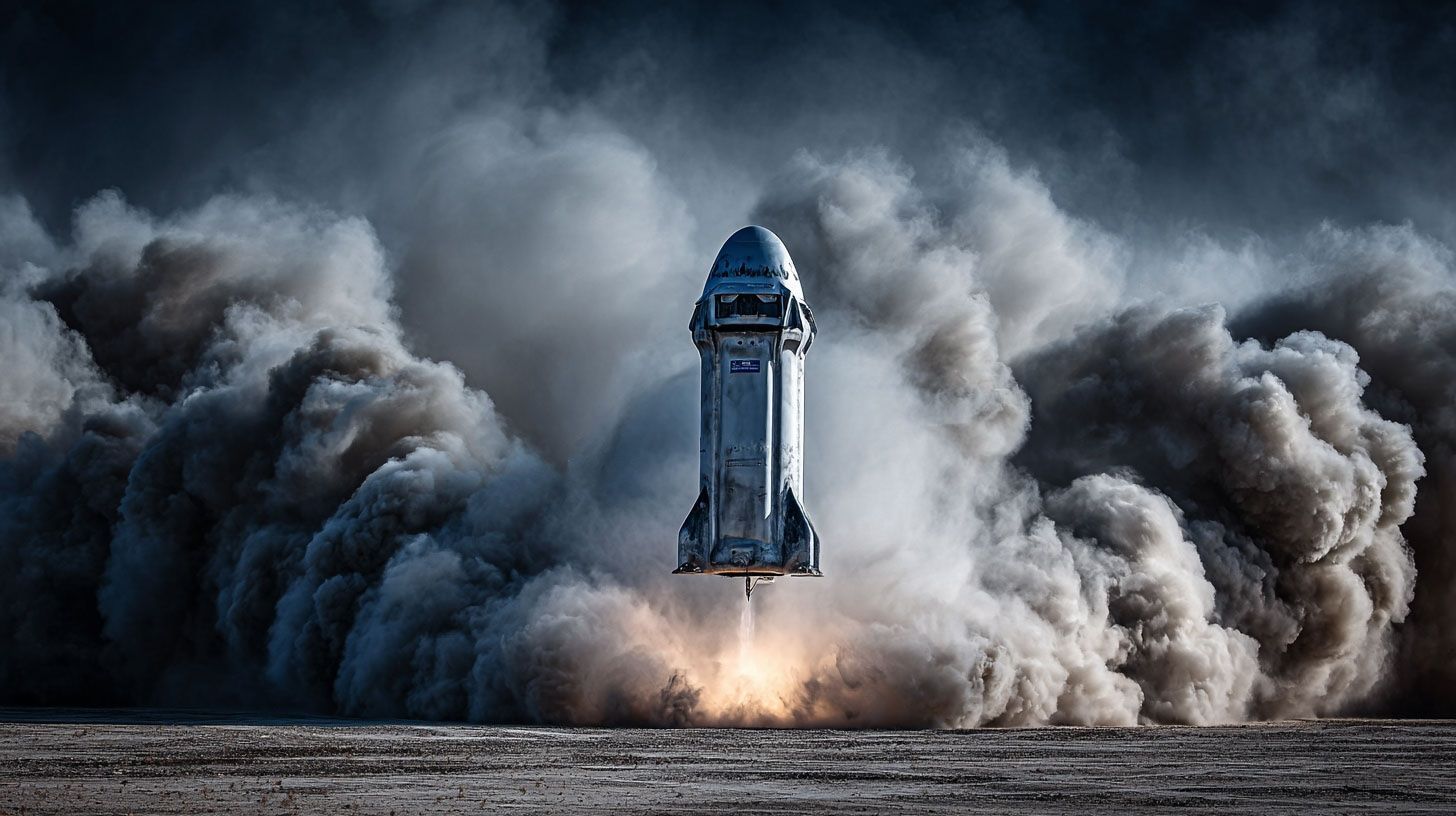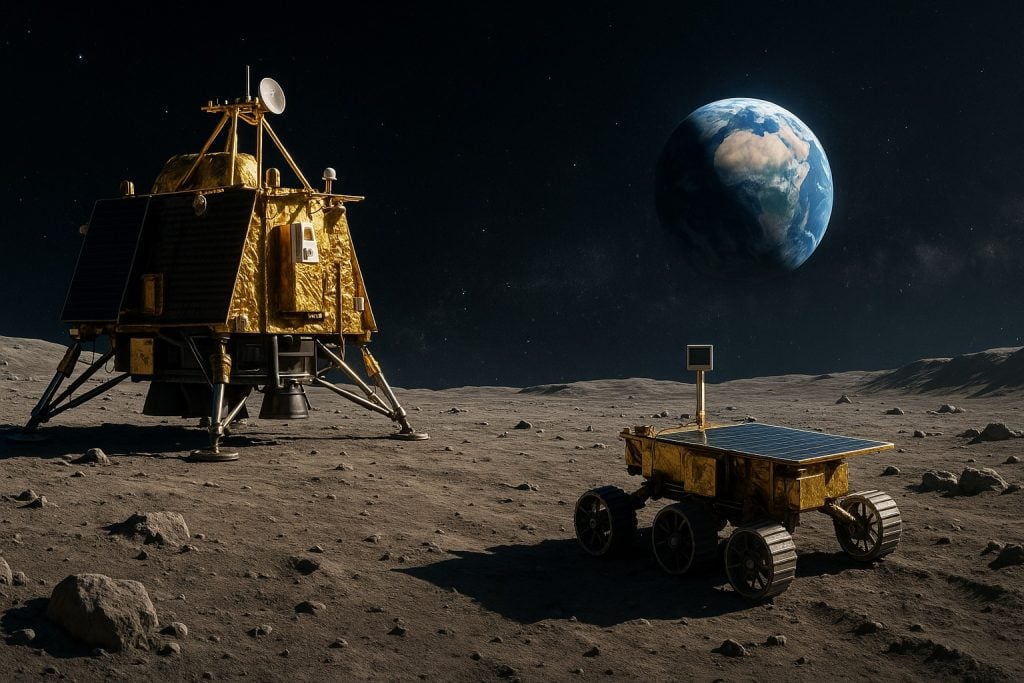- As of mid-2025, New Shepard had completed about 32 flights (12 crewed) and carried over 60 passengers.
- Blue Origin’s New Glenn heavy orbital rocket achieved its first successful orbital launch in January 2025.
- One New Shepard seat was effectively selling for about $1.3 million, well above Virgin Galactic’s roughly $450,000 per seat.
- NASA awarded Blue Origin a $3.4 billion fixed-price contract in 2023 to develop a Human Landing System for Artemis V.
- Blue Origin has secured about $8 billion in Space Force National Security Space Launch contracts, including roughly $5.6B in Lane 1 and $2.4B in Lane 2.
- In early 2025 Blue Origin employed over 10,000 people globally, including about 5,000 in Washington state at its Kent campus.
- Blue Origin’s BE-4 methane-oxygen rocket engine, developed in Alabama, powers United Launch Alliance’s Vulcan rocket.
- NASA in 2023 awarded Blue Origin $34.7 million to advance the Blue Alchemist project to produce solar cells from lunar regolith with no water or toxic chemicals.
- In 2015, Florida officials announced Blue Origin would invest $200 million in Cape Canaveral to build a launch complex and manufacturing site, creating about 330 jobs.
- The global space tourism market was about $888 million in 2023 and could exceed $10 billion by 2030, according to Grand View Research.
Blue Origin is a private aerospace company founded by Jeff Bezos in 2000, with a mission to enable commercial human space travel. Its New Shepard suborbital rocket has been conducting crewed tourist flights since 2021, and its New Glenn heavy orbital rocket made its first successful launch in January 2025 [1]. These activities have generated economic effects across tourism, high-tech manufacturing, regional development, and investment. Below we analyze these impacts in detail, with a focus on Blue Origin’s suborbital space tourism and related ventures.
Space Tourism and Commercial Spaceflight
Blue Origin’s suborbital tourism service (New Shepard) targets an ultra-high-end market. Ticket prices are not officially published, but one report noted a broker paid $2.575 million for two seats (about $1.3M per seat) on a recent flight [2]. This far exceeds Virgin Galactic’s fares (~$250–600k per seat) [3] [4]. Jeff Bezos has said that nearly $100 million worth of New Shepard tickets had been sold by mid-2021 [5], indicating strong demand from wealthy customers. Analysts project space tourism demand will grow rapidly: one study estimates the global space tourism market was about $888 million in 2023 and could exceed $10 billion by 2030 (a CAGR ~45%) [6]. Nearly half of that market is forecast to be suborbital travel (like Blue Origin’s flights).
Blue Origin’s New Shepard rocket launches from its West Texas site on a crewed suborbital mission [7]. Such tourist flights last ~10–12 minutes (with a few minutes of weightlessness) and require preparatory training. In addition to ticket revenue, the consumer spending impact includes travel, lodging, and training expenses for passengers. For example, estimates suggest an all-in cost (travel + training + ticket) could be on the order of $2 million per person. Over time, if flight frequency increases, local economies around launch sites (Texas and potentially other spaceports) will benefit from visitor spending on hotels, restaurants and related services.
- Ticket Pricing and Revenue: Blue Origin has not fixed a public price, but high sale prices have been reported. One New Shepard seat was effectively selling for ~$1.3M [8], compared to ~$450k for Virgin Galactic [9]. Bezos’s “$100M in tickets sold” remark [10] implies demand on the order of dozens of flights.
- Flight Demand & Backlog: As of mid-2025, New Shepard had completed ~32 flights (12 crewed) [11], carrying over 60 people. For context, Virgin Galactic has flown ~20 people over 7 flights, but has hundreds of customers on its waiting list (over 600 reservations reported [12], ~$80M in deposits). There is no public backlog number for Blue, but the robust ticket sales [13] suggest sustained interest.
- Market Growth: The global space tourism sector is expanding. Estimates put it at $888M in 2023 [14], growing toward $10B by 2030. Blue Origin and Virgin together hold roughly half of this market (suborbital segment) [15]. The overall “space economy” (all sectors) reached ~$570B in 2023 [16], and reusable launchers like New Shepard are driving down costs (one analysis suggests per-kg launch costs could eventually fall from thousands to ~100 USD [17]), which will further expand the market (see Global and Long-Term Impacts below).
Employment and Job Creation
Blue Origin has become a major employer in aerospace. In early 2025 the company reportedly had over 10,000 employees globally (before a ~10% workforce reduction) [18]. Roughly 5,000 of those are in Washington state (headquartered in Kent, WA) [19]. This makes Blue one of the largest space-sector employers in the Seattle region. For comparison, SpaceX had on the order of 13,000 employees in 2023, and Virgin Galactic around 744 by end-2024.
Regional job impacts are significant:
- Kent / Seattle, WA: Blue Origin’s headquarters and main manufacturing campus is in Kent. A recent state economic report notes that Blue alone accounted for over $275 million in NASA contracts in Washington (half of NASA’s $427M spending in WA for FY2021) [20]. Under that NASA economic impact analysis, Blue’s work supported thousands of high-tech jobs in the state. The company has rapidly expanded its Kent facilities: its workforce grew from ~600 in 2017 to ~2,500 by 2020 [21], and tens of thousands of square feet of new manufacturing/R&D space were added [22]. These facilities create direct jobs (engineers, technicians, machinists) and support many indirect jobs in local suppliers and services (construction, eateries, etc.).
- West Texas (Van Horn): Blue Origin’s Launch Site One near Van Horn, TX, employs about 275 people as of 2021 [23]. In a county of only ~1,900 residents, these “relatively high-paying jobs” have outsize impact [24]. Blue is one of the largest taxpayers in Culberson County and has spurred ancillary growth: the company has worked with developers on new housing in Van Horn and its engineers teach robotics classes in local schools [25].
- Cape Canaveral, FL: In 2015 Florida officials announced Blue Origin would invest $200 million in Cape Canaveral for a new launch complex and manufacturing site, creating ~330 jobs [26]. Blue is constructing a 750,000 ft² factory in Brevard County to build the New Glenn rocket [27]. These activities have made Florida a “major manufacturing center for high-tech space hardware” [28], further diversifying jobs beyond the traditional government launch base.
- Huntsville, AL: Blue Origin moved its rocket engine production to Alabama, in part due to roughly $38 million in state incentives [29]. That facility (completed ~2020) was planned to employ ~342 people [30]. (Alabama’s support lured away an investment of $200M and 342 jobs originally offered in Washington [31].)
- Supply Chain Effects: Beyond its direct hires, Blue’s projects create jobs throughout a supply network. For example, Blue contracts with specialized manufacturers: Constellium supplies aerospace-grade aluminum for the New Glenn rocket (from plants in West Virginia and France) [32]. Hundreds of smaller companies provide parts, subsystems, and services (propulsion components, avionics, composites, ground support equipment). Each Blue project thus multiplies employment via local procurement, construction of facilities, and service contracts (as reflected in NASA’s economic impact multiplier for Seattle-area jobs [33]).
Technological and Innovation Spillovers
Blue Origin’s R&D programs have yielded new technologies with broader industrial relevance. A key example is advanced propulsion: Blue’s BE-4 methane-oxygen rocket engine (developed in Alabama) has helped advance next-generation high-thrust engines. The BE-4 is used by United Launch Alliance’s Vulcan rocket, and parallels the methane-engine trend of SpaceX’s Raptor. Developing BE-4 involved innovations in materials and manufacturing that benefit the U.S. engine supply chain.
Another spillover is in in-situ resource utilization (ISRU). Blue’s Blue Alchemist project (in partnership with NASA) is developing a process to turn lunar soil into solar cells, aluminum, and oxygen. The company demonstrated solar cells made from lunar regolith simulants [34]. In 2023 NASA awarded Blue Origin $34.7 million to advance this lunar solar-cell technology [35]. Blue notes that its process uses no water or toxic chemicals and has “exciting potential to directly benefit the Earth” [36]. Such sustainable manufacturing methods could spill back into terrestrial industries (for example, low-waste silicon processing or metal extraction).
Other innovation impacts include:
- Composites and Materials: Developing large reusable rockets spurs advances in lightweight structures and heat-resistant materials (for re-entry vehicle shields). Blue has invested in specialized carbon-composite molds and welding techniques for large tanks. Materials suppliers worldwide (like Constellium’s advanced alloys [37]) gain business and improve processes through Blue’s contracts.
- Automation and Robotics: High-volume production of rockets (the New Glenn facility) requires automated assembly and inspection. Expertise in aerospace automation often transfers to other fields (e.g., precision robotics in automotive or medical manufacturing).
- Software and Controls: Reusable boosters require advanced guidance, landing algorithms, and simulation tools. While SpaceX dominates this area, Blue’s efforts (for New Shepard and New Glenn) contribute to the broader aerospace software ecosystem.
Overall, Blue Origin’s intensive R&D pushes forward the state of the art in rocketry and space technology. Many of these advances (from high-performance engines to sustainable manufacturing) can “spill over” into other sectors of the economy, supporting innovation beyond space.
Supply Chain and Regional Development
Blue Origin’s activities have stimulated local economies around its facilities through construction, infrastructure, and supplier networks:
- Kent, Washington: Blue’s Kent campus (with hundreds of thousands of square feet of factories and offices) anchors an aerospace cluster south of Seattle. It directly employs ~5,000 people in WA [38]. The recent expansion (a ~335,000 ft² R&D/production building) [39] not only created construction jobs but will support ongoing aerospace manufacturing. Companies in the region supply machine parts, flight hardware, and engineering services to Blue, strengthening the Washington aerospace supply chain (on top of Boeing and SpaceX presences). The nearby Boeing and Aerojet Rocketdyne rocket engine businesses may also interact with Blue’s projects (e.g. sharing talent and facilities).
- Brevard County, Florida: At Cape Canaveral’s Launch Complex 36, Blue’s orbital launch site and adjacent factory bring high-tech jobs and capital spending to the Space Coast [40] [41]. The $200M facility and 330 announced jobs [42] are bolstered by local subcontractors (construction firms, electrical and plumbing companies, etc.). By assembling rockets in Florida, Blue taps into the state’s aerospace manufacturing base. This presence complements Florida’s existing launch infrastructure (for SpaceX and ULA) and supports the local aerospace workforce.
- Van Horn / Culberson County, Texas: The desert launch site has minimal existing infrastructure, so Blue’s LS1 drove much of the local development. Beyond employment, Blue’s capital improvements (runway, testing pads, hangars, etc.) have been subsidized by Texas (a $7M state grant in 2025 [43]) and benefited local contractors. Anecdotally, Blue has helped Van Horn with housing (new developments for employees) and education partnerships [44]. Such community investments have multiplier effects in a small economy.
- Alabama (Huntsville): Blue’s engine plant brought nearly 342 jobs [45] and almost $200M in capital investment to Alabama (a state fiercely competed for its aerospace jobs [46]). The facility’s supply chain extends into regional machining and materials industries.
- Suppliers and Global Links: Blue’s manufacturing spans multiple locations and suppliers. For example, Constellium (an aluminum producer with a plant in West Virginia) supplies aerospace-grade plates to Blue [47]. This connects rural/industrial areas to cutting-edge aerospace projects. Internationally, Blue imports some components (as seen by Constellium’s French supply), and thus contributes modestly to global aerospace trade.
In summary, wherever Blue Origin operates, it often triggers construction projects (factories, pads, test stands), creates high-wage jobs, and boosts sales for local businesses. State agencies have noted that every Blue Origin dollar often leverages additional private investment and generates tax revenues (for example, Texas officials highlighted over $1 billion in Blue’s local investment [48]).
Private Investment and Public Funding
Blue Origin’s finances reflect a mix of Jeff Bezos’s private funding and government contracts/subsidies:
- Private Funding: The company is entirely privately held (no outside venture capital or public IPO). Jeff Bezos has poured vast personal wealth into Blue Origin. Media reports estimate on the order of $7–8 billion invested by Bezos to date [49]. In Texas, Blue itself stated its local investment had “exceeded $1 billion” [50]. This private capital covers expensive R&D (rocket development, test flights) that has no near-term commercial return. The lack of disclosure means Blue’s revenues are opaque; unlike SpaceX or Virgin Galactic, Blue has never revealed a full profit or loss statement.
- Government Contracts: Despite its private nature, Blue has secured large U.S. government contracts. Notably, NASA awarded Blue a $3.4 billion fixed-price contract in 2023 to develop a Human Landing System (HLS) for the Artemis V moon mission [51]. This eclipses early NASA Commercial Crew deals; for comparison, NASA gave SpaceX ~$2.9B (2021) for its HLS lander [52]. In military launch procurement (U.S. Space Force NSSL), Blue has been awarded about $8 billion (Space Force Phase 3): ~$5.6B in Lane 1 contracts and $2.4B in a subsequent Lane 2 round [53] [54]. These contracts will fund Blue’s orbital launch capabilities (New Glenn) and provide anchor customers (national security and NASA). Blue has also received smaller NASA R&D grants: e.g., $34.7M in NASA’s Tipping Point program for the lunar Blue Alchemist project [55].
- State and Local Support: Public entities have actively courted Blue Origin. Alabama offered ~$38M in incentives to land the engine plant [56]. Florida facilitated a $200M facility and helped secure state backing in the Space Florida program [57]. In 2025 the Texas Space Commission granted Blue up to $7 million for booster test facility upgrades [58]. Washington state has aerospace tax credits that have benefited Blue (Subsidy Tracker records ~$1.3M per year to Blue in 2022–23). While smaller in scale, these incentives aim to attract jobs and capital.
- Economic Implications: Private funding by Bezos means taxpayers ultimately do not directly finance Blue’s development costs. However, government contracts and incentives do channel public dollars into Blue’s projects (with the expectation of economic payback through jobs or strategic capabilities). Analysts note that Blue competes for these government funds with other companies (e.g. SpaceX for launches, Lockheed/Dynetics for lunar landers). The $3.4B HLS award to Blue (after a legal protest) was a major boon for Blue’s revenue, illustrating how public funding can accelerate (and at times distort) the commercial space market.
Comparison with Competitors
Blue Origin operates in a competitive landscape of launch providers and space-tourism companies. Key contrasts with SpaceX and Virgin Galactic include:
- Scale and Market Share: SpaceX dominates the launch market. In 2023 SpaceX flew almost 100 orbital launches [59], compared to zero for Blue (New Glenn’s first orbital launch came in Jan 2025 [60]). SpaceX is projecting $15.5 billion in revenue for 2025 [61], largely from satellite launches and Starlink, dwarfing Blue’s undisclosed revenue (SpaceX’s 2025 revenue is orders of magnitude higher than Virgin’s ~$7M in 2024 [62] and any publicly known number for Blue).
- Focus of Services: Blue’s niche has been suborbital tourism and developing heavy-lift rockets. Virgin Galactic also targets suborbital tourists, while SpaceX targets orbital customers. As of early 2025, Blue’s New Shepard had flown ~32 missions with 64 total passengers [63], while Virgin’s Unity had flown ~20 people over 7 missions. Virgin has a large backlog (~700+ customers) and plans Delta-class ships by 2026. Meanwhile, SpaceX has begun flying private orbital missions (e.g. Axiom and Polaris) at crew prices of ~$50–72 million per seat [64].
- Customer Price Points: Suborbital seats on Blue Origin or Virgin cost hundreds of thousands to over a million dollars. A Virgin Galactic seat was advertised at $250k (now ~$450k) [65], and one brokered Blue Origin seat was roughly $1.3M [66]. By contrast, SpaceX’s orbital flights (Crew Dragon) cost tens of millions per passenger [67], reflecting the much greater duration and altitude.
- Employees and Investment: Blue’s workforce (~10,000) [68] is smaller than SpaceX’s (~13,000+) but much larger than Virgin’s (744). In funding, SpaceX has raised tens of billions from private equity and capital markets (Starlink IPO, etc.), whereas Blue is funded almost entirely by Bezos (several billion per year) [69]. Virgin’s public stock market capitalization is modest ($0.5B), reflecting its smaller scale and lack of commercial revenue [70].
- Growth Outlook: SpaceX continues to expand rapidly (Starship, Starlink, crew/cargo contracts) with aggressive launch cadence [71] [72]. Blue Origin’s growth has been more measured; it only recently resumed New Shepard flights in 2024 and had a major IPO-like expectation tied to New Glenn’s success. Virgin, after pausing flights to build a new vehicle, expects to resume tourism by 2026. Industry analysts generally view SpaceX as having the largest economic footprint, with Blue’s impact significant but far behind SpaceX’s current scale [73] [74].
Comparison Table: The table below summarizes key metrics for each company.
| Company | Focus | Employees (approx.) | 2024/2025 Revenue | Notable Contracts / Assets |
|---|---|---|---|---|
| Blue Origin | Suborbital tourism, New Glenn orbital launches, lunar lander (“Blue Moon”) | ~10,000 [75] | Undisclosed (private) – Bezos said ~$100M tickets sold [76] | NASA Artemis HLS $3.4B [77]; Space Force NSSL ~$8B [78]; BE-4 engines (for ULA) |
| SpaceX | Orbital launch (Falcon, Starship), Starlink internet, crew transports | ~13,000 (2023 est.) | ~$15.5 B (2025 proj.) [79] | NASA Commercial Crew ($4B+) [80]; Starlink satellites revenue; U.S. military contracts |
| Virgin Galactic | Suborbital tourism (SpaceShipTwo) | ~744 (2024) | $7 M (2024) [81] | (No major government contracts; building new Delta-class vehicle) |
The table highlights that SpaceX’s launch volume and revenue far exceed Blue’s or Virgin’s in the near term. Virgin’s revenue is minimal (mostly deposits), reflecting that commercial flights have only just begun [82]. Blue’s government contracts (HLS, NSSL) are large on paper but will be delivered years from now, and its ticket sales (~$100M) are modest compared to SpaceX’s market dominance. In summary, Blue Origin is a significant player in the space economy but currently dwarfed by SpaceX’s scale, while competing head-to-head with Virgin only in the narrow suborbital tourism niche [83] [84].
Global and Long-Term Impacts
Looking ahead, reusable rockets and commercial space infrastructure have the potential to transform the global economy. Industry analysts note that fully reusable launchers (like SpaceX’s Starship or future versions of New Glenn) could cut launch costs by orders of magnitude [85]. For example, Falcon 9 reuse already lowered SpaceX’s cost to ~$2,700–3,000 per kilogram to LEO [86] (versus ~$10,000+/kg for older expendable rockets). In theory, fully and rapidly reusable systems could push the cost to under $100 per kg [87] – roughly a 100× reduction. Such deep cost cuts would open space to many more customers (small companies, universities, even tourism operators) and enable new industries (e.g. large-scale space manufacturing or mining).
These changes are already visible: global launch rates have exploded. In 2023 there were 2,664 launches worldwide [88] (over 2,100 from U.S. companies alone), compared to <170 per year before 2012 [89]. SpaceX and other reuse pioneers are often credited for this growth. According to a PwC analysis, the entire global space economy reached about $570 billion in 2023 and could reach $1–2 trillion by 2040 [90]. Importantly, commercial (non-government) activity now accounts for ~80% of industry revenue [91], and reusable launch technology (led by SpaceX, Blue, ULA) is a key enabler of this boom [92].
Blue Origin’s Role: Blue Origin’s technologies fit into these long-term trends. Its New Glenn heavy rocket (with two reusable stages) aims to provide low-cost access to orbit for large payloads. Its ongoing R&D in reusable stages and payload recovery will contribute to the “reuse revolution.” Blue’s planned Blue Moon lunar lander (for NASA’s Artemis missions) could stimulate a Moon-based economy (mining Helium-3, water, etc.) and further lower costs for Moon operations. The $3.4B Artemis contract [93] and other projects mean Blue is helping build infrastructure (landers, surface habitats) that may one day open lunar mining, tourism, or fuel-production industries.
Broader Economic Benefits: Lower launch costs and increased space activities have spillovers back on Earth. For instance, cheaper satellite launches enable ubiquitous broadband (SpaceX’s Starlink) and new remote-sensing services. Innovations in life-support and materials (from space programs) often find terrestrial uses (advanced medical devices, climate monitoring sensors). Blue Origin highlights that its lunar manufacturing tech is environmentally clean (no water or toxic chemicals) [94], suggesting potential “green” applications on Earth.
In sum, Blue Origin’s work in reusable vehicles and lunar systems contributes to a rapidly expanding “space industrial revolution” [95] [96]. While commercial spaceflight’s true global impact is still emerging, the consensus is that reducing the cost barrier (through reusability) will unleash new markets in science, communication, manufacturing, and exploration. Blue Origin’s investments today – though mostly private and long-term – are thus part of a larger economic wave that will likely reshape technology and commerce worldwide.
Sources: This report draws on space industry publications, company releases, and government reports for the latest data (see citations). All figures and quotations are from cited sources.
References
1. en.wikipedia.org, 2. www.nasdaq.com, 3. www.nasdaq.com, 4. en.wikipedia.org, 5. www.businessinsider.com, 6. www.grandviewresearch.com, 7. www.space.com, 8. www.nasdaq.com, 9. www.nasdaq.com, 10. www.businessinsider.com, 11. en.wikipedia.org, 12. en.wikipedia.org, 13. www.businessinsider.com, 14. www.grandviewresearch.com, 15. www.grandviewresearch.com, 16. www.pwc.com, 17. www.global-aero.com, 18. techcrunch.com, 19. www.commerce.senate.gov, 20. www.geekwire.com, 21. choosewashingtonstate.com, 22. choosewashingtonstate.com, 23. www.geekwire.com, 24. www.geekwire.com, 25. www.geekwire.com, 26. www.spaceflorida.gov, 27. choosewashingtonstate.com, 28. www.spaceflorida.gov, 29. www.bizjournals.com, 30. www.bizjournals.com, 31. www.bizjournals.com, 32. www.constellium.com, 33. www.geekwire.com, 34. www.blueorigin.com, 35. www.geekwire.com, 36. www.blueorigin.com, 37. www.constellium.com, 38. www.commerce.senate.gov, 39. choosewashingtonstate.com, 40. www.spaceflorida.gov, 41. choosewashingtonstate.com, 42. www.spaceflorida.gov, 43. senate.texas.gov, 44. www.geekwire.com, 45. www.bizjournals.com, 46. www.bizjournals.com, 47. www.constellium.com, 48. senate.texas.gov, 49. inequality.org, 50. senate.texas.gov, 51. www.nasa.gov, 52. patentpc.com, 53. www.geekwire.com, 54. www.geekwire.com, 55. www.geekwire.com, 56. www.bizjournals.com, 57. www.spaceflorida.gov, 58. senate.texas.gov, 59. spaceinsider.tech, 60. en.wikipedia.org, 61. www.reuters.com, 62. investors.virgingalactic.com, 63. www.blueorigin.com, 64. www.nasdaq.com, 65. www.nasdaq.com, 66. www.nasdaq.com, 67. www.nasdaq.com, 68. techcrunch.com, 69. inequality.org, 70. investors.virgingalactic.com, 71. spaceinsider.tech, 72. www.reuters.com, 73. spaceinsider.tech, 74. www.reuters.com, 75. techcrunch.com, 76. www.businessinsider.com, 77. www.nasa.gov, 78. www.geekwire.com, 79. www.reuters.com, 80. patentpc.com, 81. investors.virgingalactic.com, 82. investors.virgingalactic.com, 83. www.nasdaq.com, 84. www.nasdaq.com, 85. www.global-aero.com, 86. www.global-aero.com, 87. www.global-aero.com, 88. www.pwc.com, 89. www.pwc.com, 90. www.pwc.com, 91. www.pwc.com, 92. www.pwc.com, 93. www.nasa.gov, 94. www.blueorigin.com, 95. www.pwc.com, 96. www.global-aero.com





